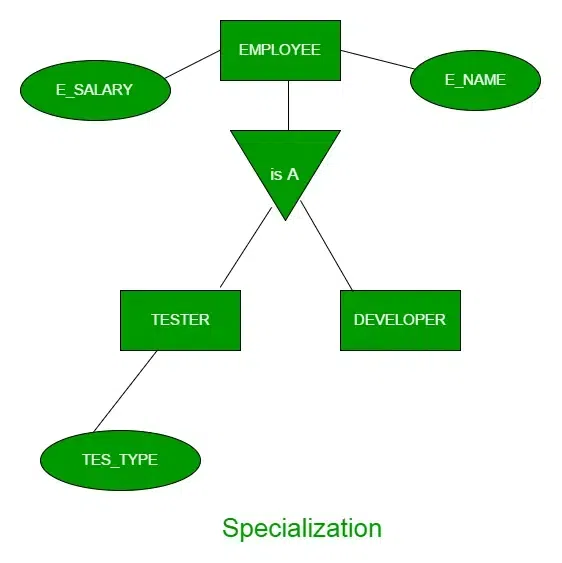Difference Between Specialization and Aggregation in DBMS
Last Updated :
22 Jul, 2023
Specialization and Aggregation in Database Management Systems are the Enhanced Entity Relationship Diagrams also known as (EER-Diagram). Specialization and Aggregation in ER model are used for data abstraction in which an abstraction mechanism is used to hide details of a set of objects.
What is Specialization?
Specialization in DBMS is the concept where the major entity is further represented by dividing it into its sub-entities. High-Level Entity is specialized into two or more two level-level entities. The parameter taken into consideration while dividing the High-Level Entity is the characteristics, according to the characteristics the dividing process into sub-entities is done. The concept of Inheritance in OOP can be related to this Specialization in DBMS, the main focus is the same to divide the Parent Entity into Child or Base entities.
Example of Specialization
Consider an entity EMPLOYEE in an Employee management system can be specialized into DEVELOPER, TESTER, etc. as shown in the below diagram. In this case, common attributes like E_NAME, E_SAL, etc. become part of a higher entity (EMPLOYEE), and specialized attributes TES_TYPE become part of a specialized entity (dTESTER).
Below there is a Visual Representation of the above Example.

Specialization
What is Aggregation?
Aggregation in DBMS is the concept where the relation between 2 different entities is considered as a single entity. In Aggregation, a relationship with its adjacent entities is aggregated into a parent or high-level entity. In simpler terms, we can say that Aggregation is used to define relationships among relationships. It shows a ‘has-a’ or ‘is-part-of’ kind of relationship where one represents the whole and the other as part.
Example of Aggregation
For Example, An employee working on a project requires some machinery. So, REQUIRE relationship is needed between the relationship WORKS_FOR and entity MACHINERY. By using aggregation, WORKS_FOR relationship with entities EMPLOYEE and PROJECT are aggregated into a single entity. Relationship REQUIRE is created between the aggregated entity and MACHINERY.
Below there is a Visual Representation of the above Example.

Aggregation
Difference between Specialization and Aggregation
|
Definition
|
Specialization defines as creating sub-entities with additional attributes or characteristics based on the parent or high-level entity.
|
Aggregation defines as combining 2 more entities to form a new entity.
|
|
Relationship
|
Created Sub-Entities are the type of Higher-Level Entity.
|
Entities are independent and also have a relationship with the aggregated entity.
|
|
Data Modelling
|
Data can be modeled using an “is-a” relationship.
|
Data can be modeled using a “has-a” relationship.
|
|
Inheritance
|
Created Sub-Entities inherit from a parent higher-level entity.
|
Aggregated Entities do not possess any inheritance.
|
|
Structure
|
Specialization structures a hierarchy of entities.
|
Aggregation does not impose any hierarchical structure.
|
| Reusability |
Specialized Entities can be reused in different scenarios. |
Aggregated entities are designed for specific cases, so may not be reusable in other scenarios. |
| Complexity |
Specialization has more complexity than Aggregation. |
The aggregation has less complexity as compared to Specialization. |
FAQs on Specialization and Aggregation
Q1: What is the use of specialization in DBMS?
Answer:
Specialization in DBMS is used when we need to describe ‘is-a’ relationship among the entities. It is used when a general entity wants to be further subdivided into more specific sub entities based on the unique properties and attributes.
Q2: Can Specialization and Aggregation be used together in DBMS?
Answer:
Yes, Specialization and Aggregation be used together in DBMS. In many scenarios, a specialized sub entity may be aggregated with other entities to generate a high-level entity. This also provisions to represent a more complex structure and database relationships.
Q3: What is the limitation of specialization in DBMS?
Answer:
Specialization in DBMS increments the complexity of database schema. As the introduction of new sub entities is done, the scheme needs to be more intricate, and additional maintenance is to be required. If the sub entities are not properly handled, then issues of data redundancy and inconsistency can occur.
Q4: What are the advantages of using Aggregation in DBMS?
Answer:
Aggregation improves the data modelling clarity and simplicity and also enhances the data integrity by treating aggregated entities as a single instance. Simplified presentation of complex structures and relationships can be done using Aggregation.
Share your thoughts in the comments
Please Login to comment...